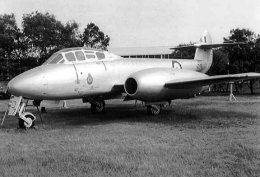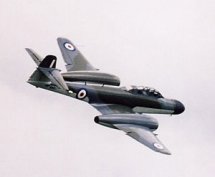
Gloster Meteor
As the first jet engines produced little thrust, Gloster was forced to design a twin-engined aircraft. As this allowed the installation of different engine types with relative ease, it was decided to test three different engines in the F.9/40 prototypes, eight of which were built.
Delay with the Rover W.2B engine (based on Frank Whittle's engine for the E.28/39 aircraft) resulted in prototype DG206/G, powered by two Halford H.1s, taking to the air first on 5 March 1943. As the other prototypes were flown, testing revealed a lack of directional stability, though these teething problems were corrected by modifications to the aircraft's tail.
On 12 January 1944, the Meteor F.Mk 1 made its first flight. This was effectively an F.9/40 powered by Rolls-Royce W.2B/23C Welland enignes (Rolls having taken over development of the W.2B from Rover) and fitted with four 20 mm (0.79 in) nose-mounted cannon.
Twelve F.Mk 1s were handed to No. 616 Squadron in July 1944 and the following month Flying Officer Dean scored the RAF's first jet 'kill', when he drowned a V-1 flying bomb. In December, No. 616 equipped with the improved F.Mk 3. In 1945 the unit moved to Holland to make armed reconnaissance flights over Germany, but no Messerschmitt Me 262s were ever encountered.
Even before Britain's first jet aircraft, the E.28/39, proved the practicality of this radical power source, Gloster was planning a new fighter to use the jet engine. After convincing the Air Ministry to draw up a specification (F.9/40) around their design, Gloster built a number of prototypes and by mid 1944 had equipped the first RAF jet unit, No. 616 Squadron. The intention was that the new jet would be pitted against Germany's jet fighter, the Me 262.
 |
 |
 |
| Issued to No. 616 Squadron in July 1944, this Meteor F.Mk 1 was written off one month later after suffering a forced landing. |
Mo. 616 Squadron, RAF, was flying Spitfire Mk VIIs when it was announced that the unit was to become the RAF's first jet squadron. Here, Mk 1s and Mk 3s can be seen at RAF Manston. |
The Meteor had a clear view canopy to allow the pilot to see the rear of his aircraft. |
|
Gloster Meteor (Technical Specification) |
| Role |
Single-seat day fighter |
| Manufacturer |
Gloster |
| Maximum Speed |
675 kmh (419 mph) |
| Ceiling |
12,192 meters (40,000 feet) |
Weight
Empty
Maximum Takeoff |
3,737 kg (8,221 lbs)
6,258 kg (13,768 lbs) |
Dimensions
Wingspan
Length
Height
Wing Area |
13.10 meters (42 ft 11 in)
12.50 meters (41 ft)
3.90 meters (12 ft 9 in)
34.70 square meters (373 sq ft) |
| Engines |
Two Rolls-Royce W.2B/23C Welland Series 1 turbojets each provides 7.56-kN (17,000-lbs.-thrust) |
| Armament |
Four Hispano 20 mm (0.79 in) cannon in the nose |
Photo Gallery
Click here to submit your photo
| Have A Passion For Aircraft? |
|
|
|










